| |
 |
Pasadena |
California |
USA |
Analemmatic Dial |
Dial 643 |
| A 14x8 foot analemmatic dial with an 8x2 foot gnomon-positioning calendar plinth. The dial is installed in the pebble and concrete patio of the Winnett Student Center. The hour markers and calendar line plinth are made of Granodiorite of Knowles, a muscovite-bearing biotite granodiorite rock quarried from Knowles Quarry at Raymond, California. A nearby wall plaque provides longitude and EOT correction. The dial is a gift from the Caltech Alumni Association as a sculpture, a public artwork and a scientific instrument. This dial is located on the private university campus but the public may walk on the campus grounds to view the dial. |
| |
| |
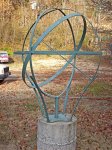 |
Marshall |
North Carolina |
USA |
Armillary Sphere |
Dial 642 |
| An armillary steel ring equatorial dial approximately 4 feet diameter. Hour ring has Roman numerals cut through the ring to show EST. Mounted on a concrete pedestal marked with city name and builder's mark. The pedestal is also marked with Marshall town map coordinates 35.79° N, 82.68° W, which are not the precise coordinates of the dial. Weathered finish is green enamel paint on steel. The concrete pedestal is marked with Marshall city name, builder's mark and approximate coordinates. |
| |
| |
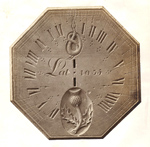 |
Pittsburgh |
Pennsylvania |
USA |
Horizontal Dial |
Dial 641 |
| A 12 inch octagonal carved sandstone horizontal dial with Roman hour numerals from 4 AM to 8 PM. The gnomon is missing. Dial face includes carved figures of a snake and a thistle and is marked latitude 40° 35'. The 1763 date ascribed to the dial's origin is coincident with the relief of the siege of Fort Pitt during Pontiac's Rebellion in that year. The 42nd and 77th Regiments of the Highland Guard and the 60th Regiment of the Royal Americans defeated the Native forces (Delaware, Shawnee, Mingo and Huron Tribes) at the Battle of Bushy Run in August, 1763, successfully quelling the Indian uprising in Southwestern Pennsylvania. The Highland Guard is artistically represented on the sundial by the thistle and the Royal Americans by the snake. Although the assignment of the 1763 date to the dial is not conclusive, the history of Fort Pitt, together with the design elements seen on the sundial and the location of its discovery, provides a plausible conclusion. |
| |
| |
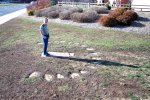 |
Hastings |
Minnesota |
USA |
Analemmatic Dial |
Dial 640 |
| A 5x3 meter analemmatic dial of natural limestone rocks with red flagstone and white limestone for month markers. Arabic hour numerals and month names are sandblasted into the stones. This dial was designed and built as an Eagle Scout project with an original request from the school science teacher, Mr. Rapatz. Roger Bailey of NASS provided technical guidance. |
| |
| |
 |
Windsor |
Ontario |
Canada |
Vertical Dial |
Dial 639 |
| Two vertical bronze-on-masonry dials on adjacent faces upper faces of a square, 25 foot high tower. Dial faces are aligned approximately SE and SW. A bronze armillary sphere is placed atop the tower. The tower and sundials were designed and built by the Windsor Polish community and dedicated in the Windsor centennial year in memory of M. Kopernik (Copernicus). |
| |
| |
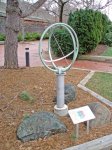 |
Sydney |
Nova Scotia |
Canada |
Armillary Sphere |
Dial 638 |
| An armillary sphere constructed from a large, dual-loop aluminum radio direction finding antenna. Outer ring is 80 cm (31.5 inch) diameter mounted on a 1.3 m (51 inch) pipe pedestal. Hour ring is stainless steel and marked in ten minute intervals showing local apparent time. A nearby plaque provides Equation of Time conversion to standard time. A second small style projects a shadow at noon local apparent time on a second vertical scale to show the sun's declination. |
| |
| |
 |
Palm Beach |
Florida |
USA |
Horizontal Dial |
Dial 637 |
| A bronze horizontal dial approximately 24 inches square on a painted masonry pedestal. Inner hour circle shows Arabic numerals for standard time and outer hour circle shows Roman numerals for local time. Dial face includes cardinal direction marks and coordinates. An EOT table is provided in an adjacent bronze plaque atop the pedestal. Dial is located on the entrance walkway to the Flagler Museum, formerly known as Whitehall, Henry Flagler's private home. Museum is open to the public but requires an entry fee. |
| |
| |
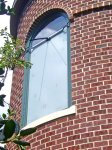 |
Richmond |
Virginia |
USA |
Vertical Dial |
Dial 635 |
| An 87 x 37 inch vertical stained glass sundial in a second story window on the south wall of a tower at Richmond Hill, a historic monastery in Richmond. The glass area of the dial is frosted with hour lines and numerals read from the inside. Richmond Hill is open to the public Tuesday through Sunday; visitors are welcome to view the sundial, which is located in a tower accessible from the main lobby entrance. |
| |
| |
|
Las Vegas |
Nevada |
USA |
Analemmatic Dial |
Dial 634 |
| An approximate 10 foot x 6 foot analemmatic dial on pavement sloping 3° to east. Hour lines and sunrise/sunset markers are brass inserts placed in pavement. |
| |
| |
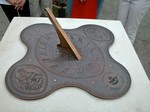 |
Great Falls |
Virginia |
USA |
Horizontal Dial |
Dial 633 |
| A phosphor bronze horizontal dial whose face is 17.7 inches across four rounded cruciform arms. Designed, made and presented by Tony Moss to commemorate the establishment of the first English settlement at Jamestown on May 14, 1607. The most striking feature is the inclusion of reproductions of the King James Great Seal of the English Virginia Company. The "navette" (little boat) shape of the seal is also reflected in a similar shape for the dial itself. These "English" features are balanced by an American input in the form of the "Celebrate Virginia" logo and that of the local Analemma Society that co-funded the pedestal along with Fairfax County Park Authority. A unique rounded-cruciform shape encompasses all the above elements together with the NASS logo and appropriate inscriptions. The dial is calibrated in 3-minute intervals and quarter hours. Square classical pedestal in reconstituted limestone made by Haddonstone UK. Pedestal is placed in a paved and railed area around the dial. A remarkable steel "safe" is provided to protect the dial and pedestal from theft or damage. |
| |
| |
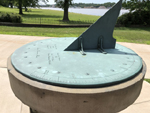 |
Rock Island |
Illinois |
USA |
Horizontal Dial |
Dial 632 |
| A horizontal dial approximately 30 inches diameter reportedly cast from an old brass (bronze, likely) cannon and weighing 175 pounds. Dial was weathered and damaged by vandals but restored in 1970 using black light to reveal the original engraved markings, which were re-engraved. Hours marked in Roman numerals with 2 minute marks. Noon gap mark aligns with North mark on base. The dial sits on a limestone base carved with crossed cannons and belt, date 1877. |
| |
| |
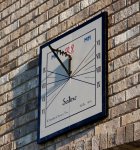 |
Saline |
Michigan |
USA |
Vertical Dial |
Dial 631 |
| A north-facing vertical dial of wood approximately 30 inches square with steel gnomon. Gnomon support includes "M M" representing 2000 millennium. Dial face includes script "RJ" for owner's initials as well as additional "M M" symbology. Hour markings show Eastern Standard Summer Time. Dial is displayed during summer months only, during which time it can be seen from the street.
Dial is on private property but can seen from a public street. |
| |
| |
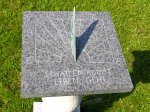 |
Norwich |
Vermont |
USA |
Horizontal Dial |
Dial 630 |
| A 12 inch square gray granite horizontal dial with bronze gnomon on a terracotta and stucco pedestal. Corrected for longitude to read EST. EOT corrections to nearest half-minute for the 1st and 15th of each month are engraved on edges of dial face. This is a private dial, not generally available for viewing. Dial sits atop a post of terracotta covered with stucco. |
| |
| |
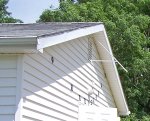 |
Ionia |
New York |
USA |
Vertical Dial |
Dial 629 |
| A 16 x 6 foot wood and steel vertical dial on the south wall of the Louis S. Wolk Observatory at the Marion and Max Farash Center for Observational Astronomy. Dial declines 16.3° W of S. Dial displays EDT with longitude correction. Pedestrian and equine access is unrestricted but vehicular traffic is limited to members. |
| |
| |
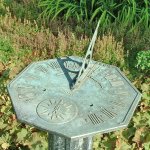 |
Yellow Springs |
Ohio |
USA |
Horizontal Dial |
Dial 628 |
| A 14.5 inch octagonal bronze horizontal dial on a cast iron pedestal. Dial was originally made for the present owner's great grandfather in the early 1900's. Face has Roman numerals with hour and half-hour markers. Compass rose cast in face aligns to magnetic north and stars of Big Dipper are shown. Dial was made originally for location near Northampton, Pennsylvania in early 1900's and is marked "41° LATITUDE." At present location, dial is tipped 1.2° for latitude correction. Two time arcs are shown on the dial face: "LONG DAY" arc extends from 5 AM to 7 PM; "SHORT DAY" arc extends from 7:30 AM to 4:30 PM. |
| |
| |
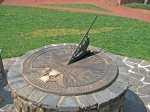 |
Lynchburg |
Virginia |
USA |
Horizontal Dial |
Dial 627 |
| A 48 inch diameter bronze horizontal dial on a stone pedestal. Polar gnomon includes a scroll and stylized peacock. Dial furniture includes an hour glass and eagle wings. The perimeter around the dial is inscribed, "TIME LIKE LIFE CANNOT BE RECALLED." The dial sits atop a cylindrical mortared stone pedestal. |
| |
| |
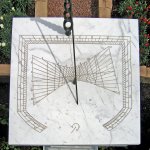 |
St. Louis |
Missouri |
USA |
Horizontal Dial |
Dial 626 |
| A unique horizontal dial 28 inches square and 1 inch thick of white Carrara marble with two cast bronze gnomons. Four time systems are shown on the dial. The shadow of the short vertical gnomon near the dial center indicates Ezanic hours based on a 24 equal-hour day with two 12-hour periods starting at sunset; Babylonian hours similarly based on two 12-hour periods starting at sunrise; and two Moslem prayer times, Zuhr and Asr. The polar gnomon shadow indicates hours based on two, 12 equal-hour periods starting at noon and midnight. The polar gnomon support consists of seven rings representing the celestial spheres of Sun, Moon, Mercury, Venus, Mars, Jupiter and Saturn. Dial furniture includes a Qibla showing the direction to Mecca, N 42.7° for this location. Dial markings are accentuated with inlaid gold leaf. This dial design is based on the Ottoman dial at Topkapi Palace, Istanbul, built about 1480, and on Ibn Al Shatir's dial in Damascus built 1371, the first sundial with a polar gnomon. Dial rests on three large carved marble blocks 42 inches high. The Botanical Gardens are public but require a moderate admission fee. |
| |
| |
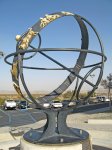 |
Joshua Tree |
California |
USA |
Armillary Sphere |
Dial 625 |
| A 5 foot diameter steel armillary sphere with 6 foot gnomon rod. Inner surface of equatorial ring has cast Roman numerals; outer surface has cast Zodiac signs colored gold. Sphere is supported by 13 inch high four-flange base. Dial sits on a 42 inch high cast concrete cylindrical base. |
| |
| |
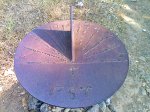 |
Ukiah |
California |
USA |
Horizontal Dial |
Dial 624 |
| A horizontal dial of welded steel plate using weld bead for hour lines and numerals. Marked for PST. |
| |
| |
 |
Sahuarita |
Arizona |
USA |
Obelisk or Vertical Gnomon |
Dial 623 |
| An unusual dial by John Carmichael using a gnomon tip to cast the shadow to indicate time. The dial face is poured concrete with inlaid metal longitude-corrected hour lines, and is nearly horizontal, inclining just 1.27 degrees for water drainage. It declines 89.28 degrees east of south. Bronze plaque has User Instructions and an Equation of Time Graph. Dial functions best during the middle part of the day. The style shadow lies outside of the dial face boundaries in the early mornings and late afternoons. The massive elaborate base that supports the gnomon rod is made from stacked flagstone. A waterfall cascades from the back south side of the base and flows a long distance to the south through a canal that has several water fountains and pools along the way. Around the base is a planter with bedding plants. The base and gnomon are lighted at night. |
| |
| |
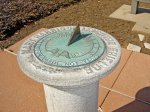 |
St. Louis |
Missouri |
USA |
Horizontal Dial |
Dial 622 |
| A 16.5 inch diameter bronze horizontal dial on a stone pedestal in front of the south entrance to the glass-walled Jewel Box building in Forest Park. The dial was erected by the Missouri Society Colonial Dames of America as a tribute to the memory of Mary Harrison Leighton Shields, who organized the Society in 1896 and served as its president until 1913. The dial face is inscribed, "WE LIVE IN DEEDS NOT YEARS." Dial furniture includes an hour glass and eagle wings. The perimeter around the dial is inscribed, "MARY HARRISON LEIGHTON SHIELDS." Dial sits atop a stone pedestal. |
| |
| |
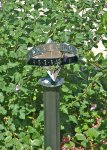 |
Toledo |
Ohio |
USA |
Equatorial Dial |
Dial 621 |
| An equatorial projection dial 18 inches wide atop a 3 foot high fluted steel column. Located on the Anthony Wayne Trail Bridge inside the zoo near its entrance, access requires zoo admission. Dial sits atop a three foot high fluted steel column. |
| |
| |
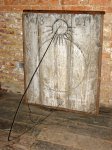 |
New Harmony |
Indiana |
USA |
Vertical Dial |
Dial 620 |
| A historic wood and iron vertical dial 34 inches wide x 42 inches high x 1-3/4 inches thick. This original Harmonist dial was made in 1821 by the Harmonie Society, a group of Lutheran separatists from Germany who settled in the US in the early 1800's. The original dial hung on a private house; when fire destroyed the house in 1844, the dial was rescued and placed on the south wall of Community House 2, located across the street from the destroyed house. A modern replica (similar at least) now is placed on the exterior wall and the original historic dial is on display inside and can be seen on a daily tour. |
| |
| |
 |
Cleveland |
Ohio |
USA |
Horizontal Dial |
Dial 619 |
| A 7 fft (2.1m) diameter semicircular inclined horizontal dial of concrete with a bronze gnomon. The gnomon support features a cast representation of a nautilus shell. Each hour arc is marked with a geologic period within the "542 million year period" most animal life has evolved. |
| |
| |
 |
Ann Arbor |
Michigan |
USA |
Vertical Dial |
Dial 618 |
| A painted steel on building brick vertical dial with a 6 foot gnomon. Gnomon includes decoration of two children and a gear wheel. Hour markings are Roman numerals. |
| |
| |
 |
Ann Arbor |
Michigan |
USA |
Equatorial Dial |
Dial 617 |
| A three foot wide brass and steel armillary of complex design with many features. Gift of Albina du Bolsrouvray. Markings are in French. |
| |
| |
 |
Ann Arbor |
Michigan |
USA |
Horizontal Dial |
Dial 616 |
| A 6 foot (1.8m) square weathering steel horizontal dial with a 3 foot (1m) high and 6 inch (15cm) wide steel gnomon in the shape of a simple triangle. Hour lines are welded steel strips, but without hour numerals. The dial is set on a steel wedge such that on sloping ground it brings the dial face horizontal. The noon gap is an artistically designed angular strip. The hour lines are offset from local, reflecting the 26 min advance from the central time zone meridian. Local mean noon (when the mean gnomon shadow falls in the noon gap) occurs at 12:26pm CST. A Plaque with the Equation of Time to convert shadow time into CST is being developed. |
| |
| |
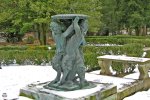 |
Lakewood |
New Jersey |
USA |
Horizontal Dial |
Dial 615 |
| A one-foot diameter bronze horizontal dial on a carved marble base depicting three satyrs holding up the dial. Sundial is original to the Gould estate, now Georgian Court University campus. The dial is supported by a carved marble sculpture depicting three satyrs. |
| |
| |
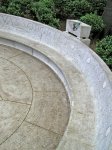 |
New York |
New York |
USA |
Sun Alignment |
Dial 614 |
| A granite park bench about 30 feet diameter whose bench shelf was designed to cast a shadow indicating time on the equinoxes. Individual curved lines corresponding to the bench shadows mark 10AM, Noon and 2PM. Known as the Waldo Hutchins Bench, the bench includes a second hemicyclium dial above its backrest; refer to Dial 250. Dial alignment may not be accurate. |
| |
| |
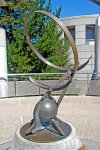 |
Oakland |
California |
USA |
Reflective Equatorial |
Dial 613 |
| One of Bill Gottesman's unique-design Renaissance dials of cast and structural bronze with a 27 inch diameter helix with a celestial-north aligned axis. Time is told by a focused beam of light that moves around the helix throughout the day. The light beam is reflected from a long cylindrical unsilvered mirror in a structure that supports the helix. A sliding time scale within the helix can be adjusted for EOT and DST and includes longitude correction. Once this scale is adjusted for date, the dial shows civil, or clock, time. The dial base is cast bronze allowing adjustment for latitude and placed on a concrete pedestal. |
| |
| |
 |
Berkeley |
California |
USA |
Armillary Sphere |
Dial 612 |
| The armillary dial is made of red bronze and rests on a quarried stone pedestal. The equatorial ring includes hour lines with 15-minute marks and Roman numerals. It was created by Frank Cheney, a UC Berkeley graduate, Class of 1941, and later donated to the Garden by his family. Mr. Cheney was a civil engineer who developed a hobby of building sundials. |
| |
| |
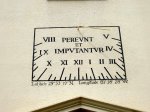 |
St. Augustine |
Florida |
USA |
Vertical Dial |
Dial 611 |
| This painted dial is about 3 by 4 feet with simple lines marking the hours and quarter hours from 8 am to 5 pm. Hours are marked with. Roman numerals. The gnomon is a replacement of the original, coming out of the wall at a perpendicular angle, then bent for the slightly declining dial. Dial's painted coordinates are about 15" south and 27" east of true (Google Earth). |
| |
| |
 |
Clifton Village |
Ohio |
USA |
Vertical Dial |
Dial 610 |
| A 35 x 23 inch vertical acrylic painted wood dial. Dial face includes longitude-corrected hour lines with Roman numerals, noon analemma, and equinox and zodiacal declination arcs. The dial is designed for a declination of 1° 18' West of South. Dial nomenclature includes location, declination and time zone offset. |
| |
| |
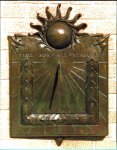 |
Wilmington |
Delaware |
USA |
Vertical Dial |
Dial 609 |
| An 18 x 24 inch cast bronze vertical dial offset from supporting wall by 6.25° to align south. Dial face has hour lines with Arabic numerals and depicts a leaf motif with sun and sun rays and two birds. |
| |
| |
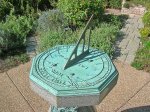 |
Peoria |
Illinois |
USA |
Horizontal Dial |
Dial 607 |
| An 18 inch octagonal horizontal dial of cast bronze. The dial face includes hour lines with ten minute marks and Roman numerals. The dial is on an octagonal polished granite pedestal. The bronze gnomon is correctly set at 40? but appears to be more modern than the cast dial face. This is one of two "sister" dials ordered cast by Grant Hood; the second dial was placed at Bradley School of Horology but later disposed and now in private ownership in Lynchburg, Virginia. |
| |
| |
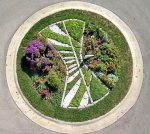 |
Lexington |
Kentucky |
USA |
Horizontal Dial |
Dial 606 |
| A 14 foot diameter horizontal dial of granite, marble and limestone with shrubbery delineation in the center of a cul de sac street. The hour lines are shaped to include analemmas to correct for EOT and are adjusted for longitude and DST. The shadow of the tip of the gnomon traces declination lines for solstices and equinoxes. |
| |
| |
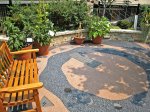 |
St. Louis |
Missouri |
USA |
Analemmatic Dial |
Dial 605 |
| A child-safe compliant surface analemmatic dial located in a roof garden. The dial face includes hour numerals, cardinal directions and moon phases. A nearby plaque give directions for use. |
| |
| |
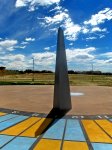 |
Colorado Springs |
Colorado |
USA |
Horizontal Dial |
Dial 604 |
| A monumental 120 foot diameter horizontal dial of painted concrete with a vertical 12 foot high concrete gnomon. Standard time and DST hour numerals are shown as are solstice and equinox lines. Dial face includes two 6 foot diameter inlaid mosaic maps of the Western and Eastern Hemispheres. The gnomon is a truncated three-sided equilateral pyramid that inclines to the north so that the northern corner is vertical. Two bronze plaques give instructions for reading and equation of time correction. Seen from above, the overall design incorporates a Yin Yang symbol appropriate for this elementary school specializing in teaching Chinese language and culture. |
| |
| |
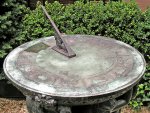 |
New York |
New York |
USA |
Horizontal Dial |
Dial 603 |
| A cast bronze horizontal dial approximately 30 inches diameter. The dial face includes the motto, astrological symbols of the ecliptic with Roman numerals. The 40-inch high cast pedestal sculpture depicts the three muses supporting the dial. This dial is visible from the street in front of the residence. |
| |
| |
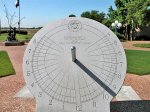 |
Euless |
Texas |
USA |
Equatorial Dial |
Dial 602 |
| A granite and stainless steel equatorial dial approximately 6 feet high. Equation of time and user information are shown on a granite lab in front of the dial. |
| |
| |
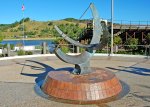 |
Grand Haven |
Michigan |
USA |
Equatorial Dial |
Dial 601 |
| A bronze equatorial dial approximately 6 feet high with bowstring gnomon. Hour markings show Daylight Saving Time and are longitude corrected. Dial sits atop a brick plinth. |
| |
| |
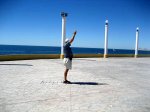 |
Puerto Penasco |
Sonora |
Mexico |
Analemmatic Dial |
Dial 600 |
| A concrete analemmatic dial set in the El Camaronero Plaza on the Sea of Cortez. The dial is 20 feet E-W across the hour markers. The dateline displays the 1st, 10th and 20th of each month. Dial includes 34 minutes longitude correction. Instructions in Spanish and English are displayed nearby. |
| |
| |
 |
Vail |
Arizona |
USA |
Analemmatic Dial |
Dial 599 |
| A brass and concrete analemmatic dial set in the Butterfly Garden at Colossal Cave Mountain Park at 3415 feet elevation. The dial is 21 feet E-W across the hour markers. A hand-held rod gnomon 143 inches long includes a bubble level for positioning. There is a modest park use fee to view this dial. |
| |
| |
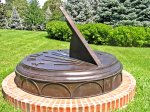 |
Omaha |
Nebraska |
USA |
Horizontal Dial |
Dial 598 |
| A 7.5 foot diameter horizontal dial of water jet cut sheet bronze and cast bronze side molding with a 45 inch high gnomon. Very large Roman numerals show hours from 10 AM to 5 PM in Daylight Saving Time with longitude correction. The bronze dial rests on a short concrete and brick pedestal. |
| |
| |
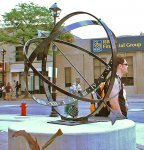 |
Burlington |
Ontario |
Canada |
Armillary Sphere |
Dial 597 |
| A simple steel armillary dial ten feet high overall on a 5x5 foot granite base. The dial is located in front of a building named in honor of William Bunton, a prominent local businessman who died in 1881. |
| |
| |
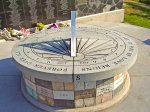 |
Toronto |
Ontario |
Canada |
Horizontal Dial |
Dial 596 |
| A 210 cm diameter horizontal dial of blue granite with a 56 cm high stainless steel gnomon. In addition to showing local time, the declination line that touches the base of the gnomon traces the path of the shadow on June 23 (date of the 1985 Air India terrorist-bomb air crash) and also marks solar noon at the crash site near Akahista, Ireland where there is a similar memorial sundial. Stones forming the pedestal represent all of the Provinces and territories of Canada, and the countries of India, Ireland, Japan and the United States of America. |
| |
| |
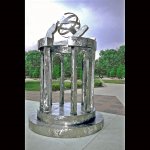 |
Delaware |
Ohio |
USA |
Armillary Sphere |
Dial 595 |
| A 24 inch diameter stainless steel armillary dial with equator, meridian and horizon rings. The armillary includes compass points and zodiacal symbols. The dial sits atop a 6 foot tall architectural sculpture of four two-columned arches also made of formed and welded stainless steel sheet with a random polished pattern creating dark and bright areas that change as the sun moves across the work. The armillary is held by fingers of a sculpted hand, representative of works by the designer, Alvin Sher, and symbolizing mankind, creativity, knowledge, peace and greeting as well as identity among many other human meanings. The dial sits atop a six foot tall stainless steel architectural sculpture with four pairs of columns with a supporting arch between each pair. The entire sculpture is made of textured and welded sheet up to 3/16 inch thick. |
| |
| |
 |
Louisa |
Virginia |
USA |
Cylindrical Dial |
Dial 594 |
| An internal cylindrical dial built in a 16 foot diameter, 48 foot tall farm silo now located on a public golf course. The rim of the open top of the silo provides an elliptical shadow line on the inner wall of the silo. This is marked out with red hour lines and black date lines using the low point of the shadow on the wall as the time marker. The artwork has "three panels representing the continuity of man's perceptions of space: past, present, and future. In an abstract sense, the sundial represents the scientific, emotional, and philosophical struggles and triumphs of mankind." Contact Tanyard Country Club Golf Pro Shop at 540-967-1889 to ensure the silo door is open. |
| |
| |
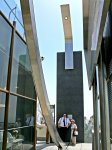 |
Los Angeles |
California |
USA |
Sun Alignment |
Dial 593 |
| A bronze-faced meridian arc dial 18 feet long, 13.5 feet high and 7 inch wide. Displays the meridian line and is inscribed with month and day markings, seasonal and lunar indicators and constellation figures. An overhead lens projects a solar image on the inscriptions. A large adjacent symbol is positioned to indicate which set of date markings is to be read from the meridian line. In a modern twist, photoelectric sensors embedded in the face of the arc are activated by the transiting spot of sunlight and send a signal to illuminate LED indicators on the 22 foot wide stainless steel ecliptic chart overhead, lighting up the stars of the constellation through which the sun is passing. |
| |
| |
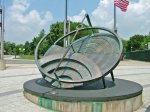 |
Queens |
New York |
USA |
Sculpture/Artwork |
Dial 592 |
| A 6 foot diameter bronze sculpture reclined 50° (latitude is 40° 45' N) with slit gnomon and hour marks. Gift of Joan and Richard Scheuer in 2000. More sculpture than sundial, it does have some hour marks but reclines and appears to be out-of-plane. |
| |